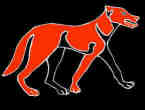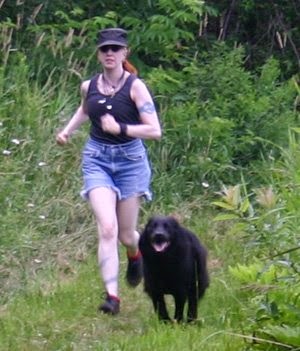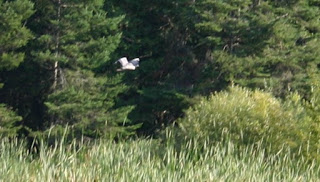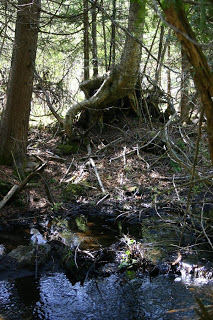Category: wilderness
Excerpt from “Going into Wolf-Shape”
This is my last of the excerpts from past issues of Air n-Aithesc that I have to share. I have previously posted excerpts from “Muimme naFiann: Foster-mother of heroes” and ‘“By Force in the Battlefield”: Finding the Irish Female Hero’. The rest of this one can be found in the first issue, Vol 1, Issue 1.
 The next issue should be out at Imbolc, in just a few weeks. I will try to post excerpts in a more timely manner at that point. ~;) Or maybe I’ll even blog something else. ~:p
The next issue should be out at Imbolc, in just a few weeks. I will try to post excerpts in a more timely manner at that point. ~;) Or maybe I’ll even blog something else. ~:p
Going into Wolf-Shape
Humans have lived with dogs for possibly somewhere between 18,800 and 32,100 years, earlier than previously believed.[i]Given highly social nature of both humans and canines and our mutual ability to hunt in groups requiring good communication skills, it seems natural that the relationship would have started when we were hunter-gatherers. Early Neolithic dog burials in Siberia suggest that during this period dogs held an high status not far below humans, beyond their “utilitarian” usefulness.[ii] How natural the relationship is between humans and canines is something most who live with dogs would readily argue, our ability to relate is a given for us. Science has been proving this point, communication and emotional response are strong and similar.[iii]It would be more amazing if humans and wolves—for dogs are wolves who choose to adapt to live in human packs—had not bonded.
There is a great deal of lore and history regarding the importance of dogs among the Gaelic and other Indo-European cultures. Recent genetic testing has revealed that the rose-eared sighthound originated among the Celtic people.[iv] This ancient hound was the ancestor of the modern Greyhound, the Scottish Deerhound, as well as the Galgo Español, which is probably very similar to the ancient hounds. The warrior and the canine are repeatedly linked in Irish lore. One Irish term for wolf, “mac tire” (literally “son of the land”), seems to have first meant a “vagabond warrior” came to primarily mean “wolf.”[v] Many warriors and kings bore “hound” or “wolf” in their names.[vi] The most recognized is Cú Chulainn, who, as a child, took the very role he became named for, “Culainn’s hound,” after killing the smith’s original guard dog in self-defense.[vii] The Fíanna were renowned for their hunting hounds.[viii]
Read the rest by purchasing Air n-Aithesc Vol 1, Issue 1
[i] Elizabeth Pennisi, “Old Dogs Teach a New Lesson About Canine Origins” Science Magazine Vol. 342 no. 6160, November, 15 2013 http://www.sciencemag.org/content/342/6160/785.full
[ii] Robert J. Losey, et al “Burying Dogs in Ancient Cis-Baikal, Siberia: Temporal Trends and Relationships with Human Diet and Subsistence Practices,” PLoS ONE 8(5) 2013 http://www.plosone.org/article/info:doi/10.1371/journal.pone.0063740?
[iii] Gregory Berns, How Dogs Love Us: A Neuroscientist and His Adopted Dog Decode the Canine Brain, New Harvest, 2013
[iv] Heidi G. Parker, Lisa V. Kim, Nathan B. Sutter et al, Genetic Structure of the Purebred Domestic Dog Science, 21 May, 2004: Vol. 304 no. 5674, pg. 1160-1164 https://www.princeton.edu/genomics/kruglyak/publication/PDF/2004_Parker_Genetic.pdf
[v] Kim McCone, “Varia II.” Ériu 36, 1985 pg. pg. 173
[vi] Joseph Falaky Nagy, The Wisdom of the Outlaw: The Boyhood Deeds of Finn in Gaelic Narrative Tradition, Berkeley: University of California Press, 1985, pg. 44, although far more is in this pages notes 19-22 found on 243-245; McCone, “Aided Cheltchair Maic Uthechair pg. 1-30, especially noted on pg. 12-14
[vii]Cecile O’Rahilly, trans., Táin Bó Cúalngefrom Book of Leinster Dublin: Dublin Institute for Advanced Studies, 1967 English http://www.ucc.ie/celt/published/T301035/index.html Irish http://www.ucc.ie/celt/published/G301035/index.html pg. 23-25, 160-163; O’Rahilly, trans. Táin Bó Cúalnge, Recession 1 Dublin: Dublin Institute for Advanced Studies, 1976 English http://www.ucc.ie/celt/published/T301012/index.html Irish http://www.ucc.ie/celt/published/G301012/index.html pg. 17-19,140-142
[viii] J. R. Reinhard and V. E. Hull, “Bran and Sceolang,” Speculum 11, 1936, pg. 42-58, Nagy, The Wisdom of the Outlaw, pg. 44, 95-97
Copyright © 2014 Saigh Kym Lambert
Warrior path training and more website updates
Many…..MANY…years ago I put together ideas for a training program for a warrior group within a larger organization which shall remain unnamed. I knew a lot of my ideas wouldn’t work out, discussions of them didn’t go well. I later took the ideas, put things back in I hadn’t bothered with for a group I helped start after leaving the large organization. Nothing really came of it, no one there really wanted to bother with it either..other than me (this was stuff I was doing or wanted to do, after all). I later took the ideas and replaced some of the cultural stuff with general liberal arts stuff and used to to develop a theoretical Sarah Connor Charm School program. At least it was theoretical until someone actually decided to do it and is going strong with it.
Bolstered by her enthusiasm, I pulled the outline out again and reworked it back for what I wanted to do for a Gaelic Pagan warrior path and added things that have come up since then and so forth. And I have now put it up on a warrior training page on the website. It will likely be tweaked on occasion as I realize I left Outlaw warriors on the older page.
 things out, should have left things out, want to word things differently, add links and what not. I did take some of the material from the bottom of the warrior path page to the beginning of the new page and also reworked some of the historical material on the
things out, should have left things out, want to word things differently, add links and what not. I did take some of the material from the bottom of the warrior path page to the beginning of the new page and also reworked some of the historical material on the
Meanwhile, I’ve done some poking at Teh Project along with some other writing. The second issue of Air nAithesc is scheduled for next month with my article “Muimme naFiann: Foster-mother of the heroes” among other yummy stuff from others. And I am continuing to get my own ass in gear training wise and need to get ready to head out for a run, in fact.
[I] cast [my] lot with the Fianna: to have rivers, wastes and wilds, and woods, and precipices, and estuaries
If you find this article helpful, please remember this was work to put together and I have animals to feed and vet
 The title comes from a passage in Standish Hayes O’Grady’s translation of The Colloquy of the Ancients, “Verily the younger son elected to cast in his lot with the Fianna: to have rivers, wastes and wilds, and woods, and precipices, and estuaries.” (it is on pg. 69, The Irish “Rue do roga in mac ba só . beith ré Féind, ní himargó, foithri, fássaigi, feda . aibhne is alia is indbera.” can be found Whitley Stokes ed., Acallamh na Senórach I, Irische Texte vol 4, part 1, 1900 pg. 71)
The title comes from a passage in Standish Hayes O’Grady’s translation of The Colloquy of the Ancients, “Verily the younger son elected to cast in his lot with the Fianna: to have rivers, wastes and wilds, and woods, and precipices, and estuaries.” (it is on pg. 69, The Irish “Rue do roga in mac ba só . beith ré Féind, ní himargó, foithri, fássaigi, feda . aibhne is alia is indbera.” can be found Whitley Stokes ed., Acallamh na Senórach I, Irische Texte vol 4, part 1, 1900 pg. 71)
The passage tells of brothers dividing Ireland, the elder’s share were the houses, domestic herds, riches and civilized men. After the elder’s murder, the younger avenged him and took all of Ireland back, giving the leadership of the Fianna to Morna, eventually to pass to Finn MacCumhail, of course. It’s a phrase that struck a cord for me, the indication is that the younger son preferred the wilderness, for he chose it, and that this was seen as an equable division. For the wilderness always seems preferable to me and I have come to see it as the best place to cast my own lot, while so many have turned their backs on it.
I have lived in urban areas, but at one point even then I identified as the Outlaw, one of the wilderness, acting as an Outsider in a couple of Druid groves to which I never actually belonged. One became a very formal role. However, when this arrangement ceased to be, mostly due to my acting on behalf of the members as I should and becoming scapegoated by them (which too may be fitting for for that role), I made the mistake of trying to go Inside. As many others do, I became interested in trying to create some sort of community, broadly based with many roles. A focus on culture. It burned me out. It wasn’t my place.
It seems that for most Gaelic Polytheists there is a strong focus on the civilized culture of the Gaels and finding ways to recreate it or even who claim that they live in some form of Gaelic community (I’m referring to those who are here in the US). Some are very focused on recreating what they see as Pre-Christian society, although most of our information is actually well into the Christian period. They are trying to reconstruct the concept of the túath, often complete with the class system. Others look to the later and modern Gàidhealtachd/Gaeltacht. In both cases there is often a lot of, rather necessary, adaptations which I found I am not comfortable with.
I don’t live in the Gàidhealtachd, I do not live anywhere where it once existed; I simply live where some from those lands, with those languages, immigrated. And gave up their language and culture to assimilate because that was the option they saw best at the time. I can’t pretend that I am truly part of a living culture nor can I create a childhood of “Gaelic traditions” despite having both Scottish and Irish ancestry (along with French). There is a generation between myself and my last Gàidhlig speaking ancestor, two generations between myself and my last Gaeilge speaking one. Like my father who was Québécois they saw assimilation into “America culture” very important for survival and the survival of their children, especially in light of the discrimination that they experienced first hand. I might see this as sadly short-sighted, but I can’t pretend it wasn’t what happened.
This is not to dismiss the importance of the cultures, then or now. We must learn about them to understand them. We must support the living cultures so that they can grow and continue, including keeping the languages going. But this is different than claiming we are living in them, unless we are actually living in the Gàidhealtachd, something which is not an option for most of us.
But would I fit in these cultures if I were born to them? Outside of what we must now accept are Victorian fantasies of multitudes of women warriors fighting as equal to the men, um, not so much. I’ve already noted that accounts of female warriors in the literature are predominantly Outlaws, aside from Medb and her sisters and Macha Mongruadh, who were instead Queens. Not common, everyday, in the community soldiers.
The more I read and reread the writings of McCone, Nagy and Sharp as well as sections of the literture, the more I am convinced that these warbands constituted more than just a way-station for young men between fosterage and gaining inheritance and adult status.The the Fianna/díberga were fully a counterculture, albeit one of the wild, to the more civilized culture that they protected. And a very Pagan one possibly well into the Christian period. I believe we must try to understand this wild culture too, as much as the civilized one we know more of. We might never be able to know enough about it, but this is the situation we have with all Pagan Gaelic culture…we have no direct information from those living it, our “myths” are not actually myths but Christian literature. This, as I keep noting, why we “Reconstruct,” because we do have to.
 This also brings to mind the popular debate about whether Gaelic Paganism is a nature religion or not. Many other cultural Reconstructionists are much clearer that they are not, as some are very urban religions often in conflict with nature. There does seem to be some of that in the more Gaelic ways which are more mainstream and focused on the culture. The romanticism that all of Celtic religion is based in nature, rather than a defense from nature, is, well, romantic. But the Outlaws were of nature, so I can keep that romanticism all I want. Even while actually living with it, understanding why there is often a hostility to it from those who didn’t and don’t have the luxury of seeing it from afar while in their safe houses or apartments, eating food they picked up from a grocery they traveled paved roads to go to and really being separate from that nature they claim to love. Of course, some of us get very romantic about hardship even as we’re in it….some of us cal ourselves homesteaders.
This also brings to mind the popular debate about whether Gaelic Paganism is a nature religion or not. Many other cultural Reconstructionists are much clearer that they are not, as some are very urban religions often in conflict with nature. There does seem to be some of that in the more Gaelic ways which are more mainstream and focused on the culture. The romanticism that all of Celtic religion is based in nature, rather than a defense from nature, is, well, romantic. But the Outlaws were of nature, so I can keep that romanticism all I want. Even while actually living with it, understanding why there is often a hostility to it from those who didn’t and don’t have the luxury of seeing it from afar while in their safe houses or apartments, eating food they picked up from a grocery they traveled paved roads to go to and really being separate from that nature they claim to love. Of course, some of us get very romantic about hardship even as we’re in it….some of us cal ourselves homesteaders.
This is the land I belong to now, although my people are late comers. I don’t own it, it owns me. I can’t tame it, it wilds me. It feeds me, it homes me, it both protects and challenges me and I care for it as best I can. I am of the rivers, well brooks anyway, “wastes” and wilds and woods, although the closest precipices are a bit of a hike and I’m rather far from any estuaries. But lots of fresh water swamp. We share it with the deer, the coyotes, the fox, the bear, the stouts, the squirrels, the beaver and countless birds. This is my religion and if not culture then it is my community.
copyright © Saigh Kym Lambert